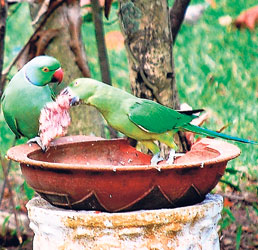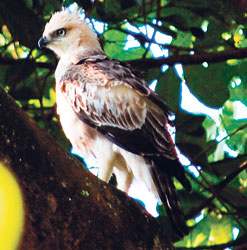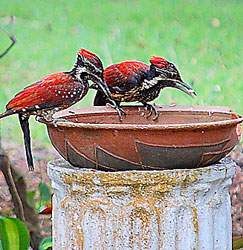When 2010 brought a change of location for a ‘Godaya’ from the Deep South, my employment requiring me to move to Colombo, it was a decision taken with reluctance. We rented a house in Battaramulla, an area where rapid urbanization is taking place but still carries street names related to the village; Milla Gaha Kamata Para and Bogaha Hena Para.
Our house is on a block of land, with a forested garden, laden with jak, teak, wild-almond (kottamba), pihimbia and cashew trees and the giant lianas scaling these trees gives the feeling of a rainforest amidst a concrete jungle. The surrounding area is also mainly unbuilt land purchased as investment by the prosperous when the real estate trade was a promising investment. These lands still hold the habitat that would have existed about 50 years ago. This peculiar and exceptional habitat is definitely a solace to a reluctant Godaya like me in Colombo.
 |
 |
| Rose-ringed parakeets |
Changeable Hawk Eagle |
My habit of feeding the local bird population with leftover food and kitchen scraps showed numerous bird species adapting to feed on such food hitherto never thought of. Have you ever heard of Woodpeckers, the parakeets in the wild, the Indian Koel (koha) and the Barbets (jumbo kottoruwa) all feeding on cooked rice?
This unusual behaviour made me study this isolated habitat in detail and the findings were amazing. This one to two acre semi-forested area was found to hold two fully grown porcupines that are active nocturnally when the high pedigree canines are locked up in their compounds, over 30 species of birds, a small troupe of Purple-faced leaf monkeys, two species of mongooses, the nocturnal civet cats that stalk the attics in the night, and of course, the ever common three stripe squirrel.
This species richness has even attracted some of the larger birds of prey. The Changeable Hawk Eagle and the Crested Serpent Eagle are frequent visitors to hunt the unsuspecting fauna. A pair of White-bellied Sea Eagles has made the Lanka Bell tower their nightly roost after scanning the waters of Diyawanna during the day for tilapia, their favourite fish. Of the migratory birds, the Blue tail bee-eater, the Indian Paradise fly-catcher (siwru hora) and the Indian Pitta (awichchiya) are found in abundance.
These habitats are exceptional and special in terms of ecology and bio diversity, though most urban dwellers are blind to the existence of such localities, and are of the opinion that they are a hazard for safe living. These semi overgrown lands are considered as breeding grounds for mosquitoes and safe havens for the venomous crawlies.
 |
| Red-backed Woodpeckers |
However they have a bio-diversity of their own. Such fragmented habitats are named an island biogeography in the study of ecology. Ecologists Robert MacArther and E.O .Wilson coined the term theory of island biogeography when attempting to predict the number of species that would exist on a newly created island.
The theory of island biogeography holds that the number of species found on an island is determined by two factors, - the rate of immigration and the rate of extinction. These are mainly determined by the size of the island and its distance from the mainland. This theory holds true to fragmented habitats of this nature in urban locations. The theories of extinction and immigration can be applied to them as well.
This type of urban forests on the other hand, plays an important role in the ecology of human habitats. They are a vital source for filtering the air, water, sunlight and providing shelter to animals. They even act in order to moderate the local climate, slowing down wind, resisting storms and gales and in turn conserving energy. They are critical in cooling the urban heat-island effect, thus potentially reducing the ozone content which increases the temperature in the cities.
In developed countries there is common understanding of the importance of these natural ecologies with numerous projects aimed at restoration and preservation of such urban forest ecosystems. They range from simple methods of elimination of fallen leaves by raking to elimination of invasive plant species in them and reintroducing original plant species.
Exposure to this type of investigative observation to the layman may trigger a need for conservation, need for preservation etc, etc. However, this feeling is to be short-lived. The recent awareness programmes on the dengue epidemic was to see a frenzy of cutting down trees and clearing ground vegetation until the rains brought back the stripped vegetation but for the trees that were cut down. This could be the beginning of the so-called ‘extinction’ in the theory of island biogeography.
The woodpecker opting for cooked rice from its instinctive food, the tree grubs is the result of habitat destruction. Parakeets adapt to other food due to the lack of nut trees and flowering trees. Even though the surviving species may adapt in such a manner for their food requirements, their breeding habits would need a much longer time to change.
These habitats would not last that long as man’s need to build will not cease and this remaining green patch at the furthest end of Udumulla Road in Battaramulla with its species richness will be gone within the next five years.
(The writer is a Life Member of the Field Ornithology Group of
Sri Lanka of the Department of Zoology, University of Colombo, and was coordinator of the of the Important Bird Areas Programme (Phase 1) in Sri Lanka). |




